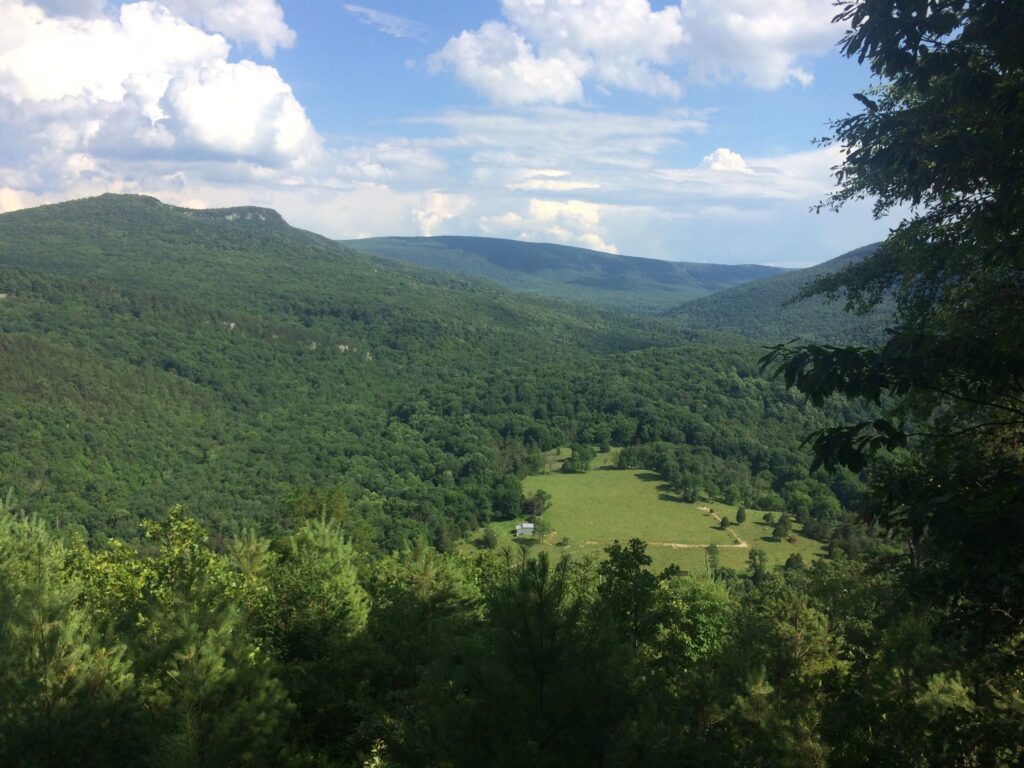By: Dominic Piacentini
Dispossession can be a creeping process. In addition to more flagrantly recognizable modes of dispossession (i.e. the forced and coerced removal of people from their land), the culmination of minor events can cause certain places and ways of being to become so unlivable that they are ultimately avoided.
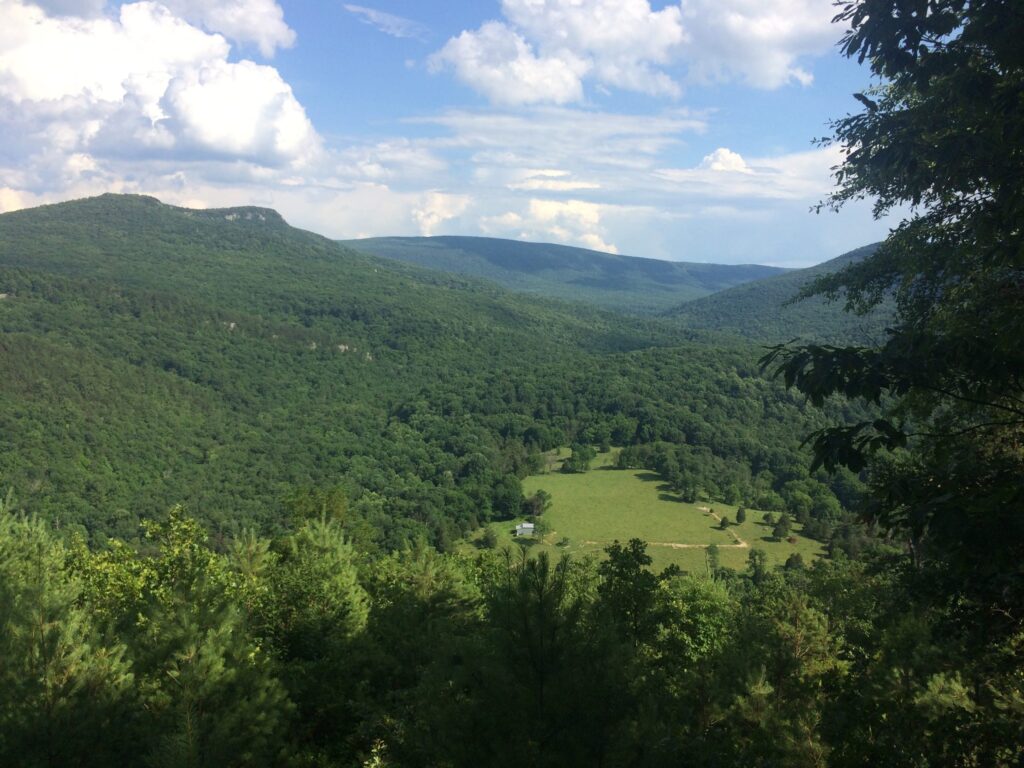
Dispossession can be a creeping process. In addition to more flagrantly recognizable modes of dispossession (i.e. the forced and coerced removal of people from their land), the culmination of minor events can cause certain places and ways of being to become so unlivable that they are ultimately avoided. This occurs across the globe, including North America and in Central Appalachia, where many rural smallholders in the region have been dispossessed of their land by large, often extractive and absentee, corporations. For those who remain, the pressures of dispossession are folded into seemingly ordinary and sometimes cruddy everyday life. No doubt dispossession manifests as abrupt events — crises of removal and enclosure — but changes to the land and our capacity to live in it have a habit of creeping up on us.
Stanley:
Years ago all of this area had beautiful, large trees — some of the largest trees on the East Coast — but they logged it and took everything. You’ll find a number of places in the county where lumber companies just bought the whole mountain. They just demolished them, and they’re gone. Now that wasn’t the case here. In our area, it was the National Forest and still is. The Forest Service is trying to keep the nature going by controlling the plants that they do have, by clearcutting patches just here and there, and reseeding the trees, and so on. They haven’t done it yet, but up here on Molly’s Hill, there’s supposed to be some more clear-cutting in a good many small places.
Folded into the Virginia–West Virginia border lies a valley farm enclosed on three sides by national forests — West Virginia’s Monongahela National Forest and Virginia’s George Washington National Forest. Stanley, who is now 93 years old and hard of hearing grew up on this farm in the 1920s and 1930s. As a child, he would collect teaberries in the woods during recess; he is, in his own words, “one who believes in climate change and so on.” For many in North America, farms may conjure images of flatness, ecological simplicity, and large-scale agroindustrial production. Stanley’s farm, however, is a diversified, subsistence-oriented homestead — not unlike other “farms” scattered across Appalachia and the rural United States.
While I stay at Stanley’s farm for a few days, his grandson, Garrett, takes me on an ATV tour of the land and surrounding hills. Garret shows me the farm’s “wolf tree” — “the largest tulip poplar you’ve ever seen” — a tree that instead of being logged, grew with the homestead. The farm has 200 maple trees tapped, an orchard, a field, a vegetable garden, grape vines, and berry bushes. Garrett is trying his hand at nurturing Pawpaw and American Persimmon trees — fruits native to these hills. A family cemetery also lies on the farm where Stanley’s parents are buried. Garrett says that he expects he’ll be buried there himself. Life on this farm has been and continues to be difficult. Adapting to changes in ecology, policy, and the market over the last century has required a great deal of effort and trial and error to make this farm work.
Describing the persistence of homesteads and subsistence farming practices in “the age of capitalism,” Jason Strange (2020) argues that while “there are neighborhoods in Oaxaca where you can’t light off a bottle rocket […] without hitting an anthropologist,” (xiii), homesteaders in the United States carry on without such attention. All the same, Strange says “pretty much everywhere that land is not insanely expensive or forbiddingly arid” (xiii), you will find people engaged in some degree of subsistence. Stanley has worked on this homestead since he was a small child, and he recalls how hard it could be growing up on a farm in the 1930s.
It was in the winter of 1933, when Stanley was 7 years old, that his father died of pneumonia.
S:
After my father died, my mother was the commander. She saw that we worked. It was rough, but we made it.
Besides what they grew on the farm, Stanley, his mother, and his siblings gathered “wild things out in nature.”
S:
The most productive [wild] thing for us was black walnuts. We would gather the nuts in the fall, and then work ‘em up. I tell you, finding some way to make money in the winter for farm people back in the thirties… Walnuts were one thing, and there’s no telling how many we cracked. My mother would usually crack a big bucket of walnuts in the day, then the family was supposed to get together with them all piled up on the table. And that was before electricity. We had a lamp setting on ‘em. A crock or something in the center to illuminate it. And, it wasn’t very good light as you can imagine. But they would pick ‘em out. When I was a boy, I wasn’t big enough to pick ‘em out, so I laid down on the bed and slept while they worked, haha.My mother would ship as many as 30 pounds of walnut kernels to Baltimore, and they would buy ‘em there. It was pretty good income for us.
Dominic:
Your mother sounds tough!
S:
I tell you she worked.
D:
We saw some hickory nuts around. Did you collect any of them?
S:
We would get some. They were not for commercial things. Usually we would crack ‘em to eat. Maybe put them in confections of various kinds, and so on. But oh, we liked ‘em! We didn’t have really good hickory nuts here, but up Trout Run, there was one place where they had hickory trees that were really nice — very large kernels. Sometimes we would get hickory nuts from those people up there. They were a lot better. So many of the nuts down here were small, and they were not easy to get the kernels out of.
D:
Hickory nuts are tough to open.
S:
No, they don’t open easy, haha! White walnuts — sometimes we would crack those too, but not often.
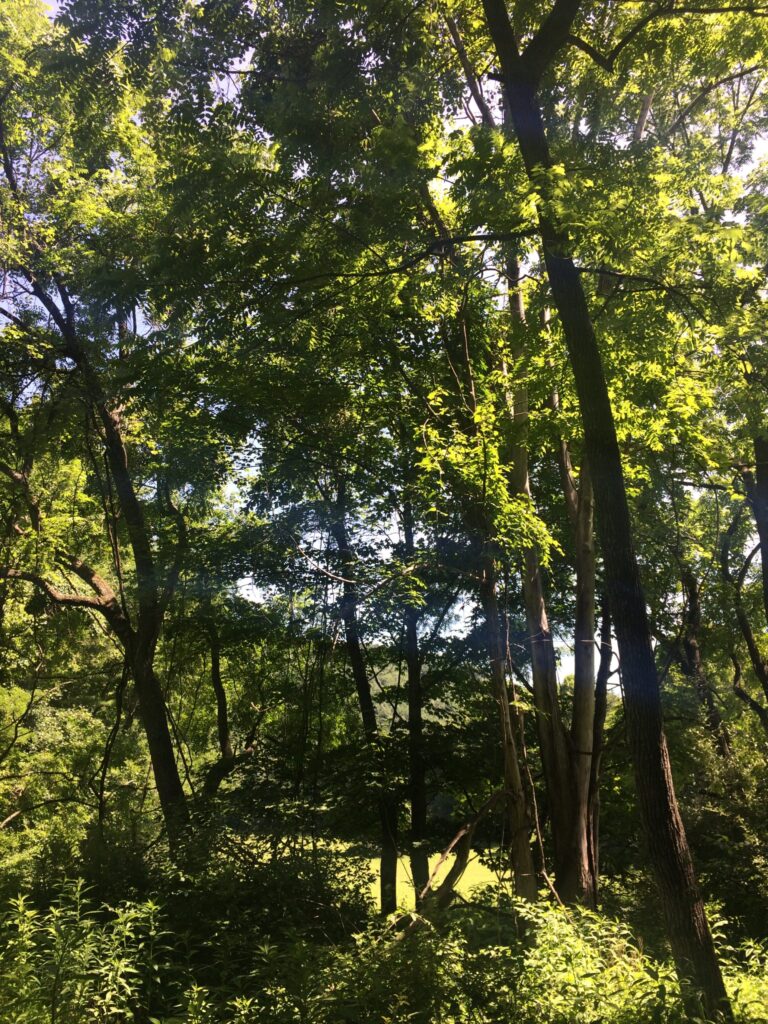
When I asked Stanley how long he had been gathering wild foods out in the woods, he showed me two small scars on his index finger.
D:
How long have you been foraging? Is it something you did growing up?
S:
Well, I guess from the time that I was a boy — wild berries, and so on. As a matter of fact, I still have a mark here. A copper snake got me while I was picking wild strawberries. I was probably between 10 and 12 years old. We always looked for wild strawberries in the spring if we could catch them.
D:
What did you do after you got bit by the snake? Were you by yourself?
S:
Oh, haha, I was by myself. I ran back to the house as fast as I could. First thing I did was put a tourniquet on my finger. Then I went to a doctor — of course it was a good while afterward before I could get in back at that time — but the doctor slashed two cuts on my finger and put potassium permanganate in. My arm swelled up; I looked like Popeye! It was an event to remember. You can see that my finger has been scarred ever since.
Besides black walnuts and wild strawberries, as a boy, Stanley remembers collecting large quantities of huckleberries.
S:
I think the thing we got the most quantity from was huckleberries. When the season was right, we would get gallons of them. My mother was a good picker. She would get up to almost three gallons in a bucket.
D:
And were the huckleberries in the hills around here?
S:
Yeah, they were in the wooded areas, in the hills and the National Forest and so on. There was no problem if we wanted to pick those. We didn’t have to have government permission. It was just open to everyone!
D:
What did you do with all of the huckleberries once you collected them?
S:
Most of them were canned. Whenever we had a quantity, they were preserved in cans. They made good pies and all sorts of things like that. I have to say, one time my brother and I got so tired of picking huckleberries that we put a bunch of leaves in the bottom of the bucket to make it look like there were more berries. Haha, when we got home, my mother was so mad. She said, “I’m gonna serve you leaves for lunch!” It’s been a long time since I’ve been picking. Times have changed, and I haven’t been in the woods as much. Recently, I just can’t get out. But the season has been changed so many times. There’s not enough rain, or there’s too much. Last year, a number of things didn’t pollinate correctly because it was too wet. And my blueberries that I had here… It was the poorest crop that I’ve had. And I think it was the rainy weather; they just couldn’t pollinate right.
Later, after I turn off the recorder, Stanley tells me another story: a year after the national forest clear cut a portion of the hills above the valley, a severe flood caused Stanley’s farm serious financial and structural damage. The flood also dispersed the seed of the “mile-a-minute vine” across the entire valley. While huckleberries have disappeared, the mile-a-minute vine crawls through the hills, entangling all sorts of plant life. It’s got thorns and prickles all along the stem and under the leaves; it even clings to your pant leg as you ride through the hills on an ATV. Garrett believes that it was the mile-a-minute vine that strangled out the huckleberry populations.
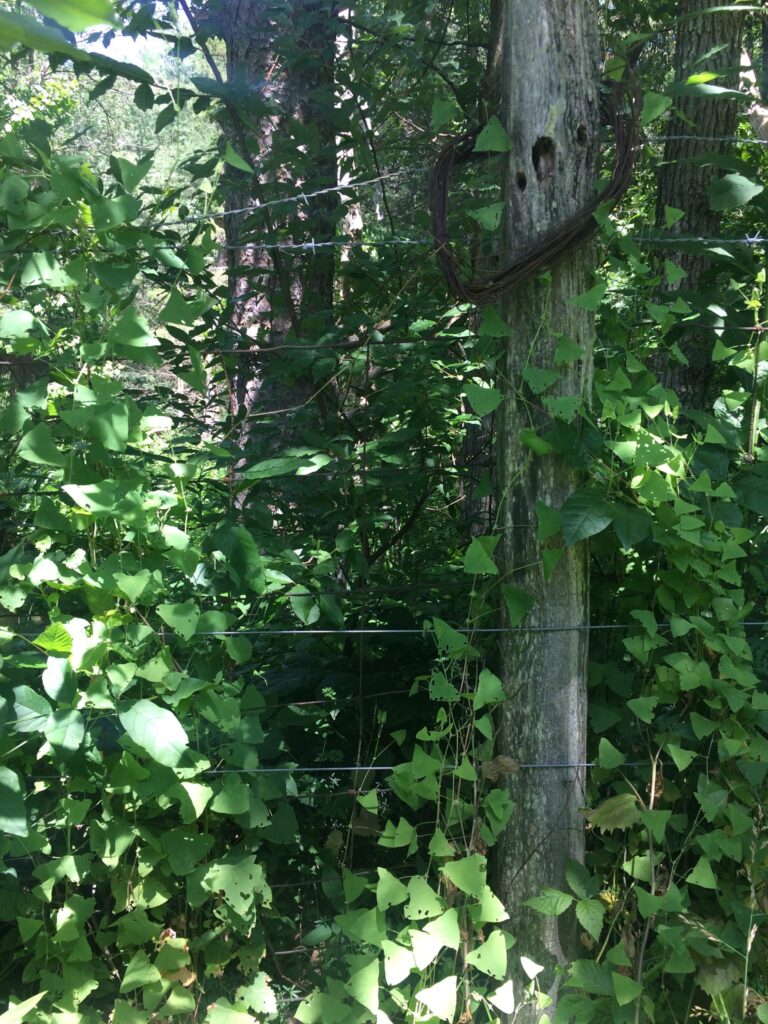
As we talk, the conversation turns from wild foods and gathering to the national forests and land management decisions and the impacts that quite literally roll downhill into the valley. Like the mile-a-minute vine, other plants and insects have spread throughout the valley farm in the last fifty years.
And this is a sad thing. The management people don’t consider what’s going to happen. They’re trying to solve one problem and they add multiple problems for the people and nature. That’s the dilemma; it upsets the whole chain.
D:
Can you tell me about some of the changes to the land around here?
S:
I tell you, it was something terrible! The first mistake they made was bringing in multiflora roses. I think the workers in wildlife were trying to provide food for animals and birds and so on. And that was a wonderful thing; the birds were happy. But the problem was they ate the seed and scattered them all over the county. It became a miserable thing — all kinds of problems. When I came back to the farm in 1988, after being in Kansas for a while, this hill was completely covered with multiflora roses — big bunches that bent over to the ground. How could I get rid of them? The answer was goats! I had friends who gave me goats. I brought the goats in, and the goats loved multiflora roses! The goats would eat enough of the canopy so that I could get underneath and cut them down with a chainsaw. Then I’d roll them down the hill and burn the things. It was some operation to do it, but I finally got it. But now the other big mistake they made was autumn olives, which they brought in. And it’s not just here, but every place. Autumn olives have just about covered everything up on the farm now. And we have to spray to kill the thing. It is just too much to do any other way. I think this is the problem with those in wildlife. They don’t consider what’s going to happen if they bring something in. And it can be true with insects as well.
D:
Was that the National Forest who did that?
S:
That was in the National Forest, but it’s just a national problem. And this is a sad thing. The management people don’t consider what’s going to happen. They’re trying to solve one problem and they add multiple problems for the people and nature. That’s the dilemma; it upsets the whole chain. A number of things that they bring in are supposed to be control, but I tell you, stink bugs and so on — it’s just horrible what’s happened to the apple crop.
D:
Garret showed me the remaining tree in the old orchard. Did there used to be a lot more apple trees?
S:
There were a number of them there; my dad had a nice orchard across the creek. And it wasn’t too hard to control when I was a boy. Insects were not that bad. I remember one red delicious tree. Boy those were big, delicious apples. There were a number of others too. Most people would have their own orchard around here, and it was easier to grow ‘em because you didn’t have that many pests on them. But now it is an entirely different story. There are so many insects that we have to contend with now that just were not here 50 years ago.
A solitary apple tree has persisted through a century of dramatic changes to the land, wildlife, and weather — though a branch was knocked down when Garrett unintentionally hit it with his mower earlier that week.
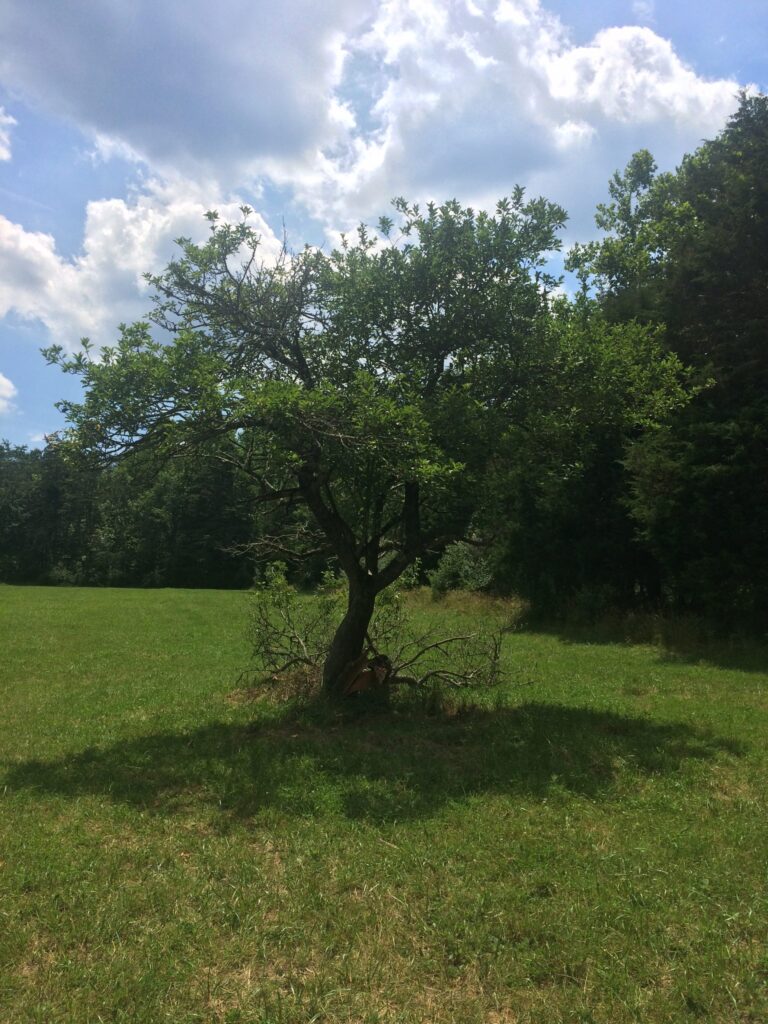
Like the mile-a-minute vine, dispossession and the enclosure of land have a way of creeping up on us. The challenges that Stanley and his family face as they maintain their farm demonstrate that enclosure and dispossession are cumulative processes, the aggregation of multiple events, and need not be the result of a single regulatory moment.
A feature of David Harvey’s “accumulation by dispossession” (2005) is the construction of resource management crises that must be “fixed.” When autumn olive was first introduced, its intended purpose was to control erosion, a fix for the valley floods which worsened after the U.S. Forest Service began clearcutting sections of the hills. These “fixes” have rippling consequences that impact life and livelihoods. To produce timber for a growing 20th-Century economy, the National Forest needed to be clear cut. Clear-cutting the forest induced a devastating flood that carried with it the seed of mile-a-minute vines. Mile-a-minute vines crowded out productive huckleberry populations. To prevent floods and erosion, the forest service plants autumn olive, and so on. In terms of property, Stanley’s farm is enclosed on three sides by national forest, but ecologically, land management decisions continue to enclose the possibilities of his valley farm.
Like the mile-a-minute vine, dispossession and the enclosure of land have a way of creeping up on us. The challenges that Stanley and his family face as they maintain their farm demonstrate that enclosure and dispossession are cumulative processes, the aggregation of multiple events, and need not be the result of a single regulatory moment. In their examination of regulatory changes to New Jersey’s marine commons, Murray et al. (2010) describe a flurry of compounding impacts reducing user options and flexibility. These creeping effects are often indirect consequences that make subsistence just that much more difficult. “Nothing happens that rises to the level of an ‘event’ let alone a crisis,” Elizabeth Povinelli remarks (2011, 4). According to Stanley, the Forest Service has never consulted with their farm about downhill consequences. When I ask Stanley about his relationship with the forest he says, “So far as they’re concerned, we’re happy with each other. Haha. We don’t have any trouble.” Speaking on the aggregation of impacts to the farm and hills, Stanley says, “I think a number of things are not as productive as they used to be. Probably the change of animals, wildlife, and so on, weather, and a whole number of things have changed, but they are still available.” They are still available even though there are no longer gallons of gatherable huckleberries, though there are no big red delicious apples growing across the creek, though new bugs and pests make growing things more difficult, though a whole number of things have changed.
Dominic Piacentini is a PhD Candidate in Anthropology & Environmental Policy at the University of Maine. His research concerns the effects of environmental policy on customary land access and resource use.
All images and text copyright Dominic Piacentini 2021.
References
Harvey, David. 2005. A Brief History of Neoliberalism. New York, NY: Oxford University Press.
Murray, Grant, Teresa R. Johnson, Bonnie J. McCay, Mike Danko, Kevin St. Martin, and Satsuki Takahashi. 2010. “Creeping enclosure, cumulative effects and the marine commons of New Jersey.” International Journal of the Commons, 4 (1), 367–389.
Povinelli, Elizabeth A. 2011. Economies of Abandonment: Social Belonging and Endurance in Late Liberalism. Durham, NC: Duke University Press.
Strange, Jason. 2020. Shelter from the Machine: Homesteaders in the Age of Capitalism. Chicago, IL: University of Illinois Press.
